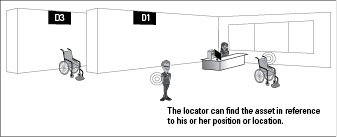Chapter 13
Locating by Associating
In This Chapter
Understanding when locating by associating is necessary
Getting to know the underlying technologies
Exploring the practical applications of locating by associating
When you report the location of a person or object by associating, you report the location of that object in reference to another object. For example, a child is near her mother, or the doctor is with a patient. A mountain rescue team searching for avalanche victims, for example, can use handheld computers to locate tags worn by victims. Each rescuer’s device reports a victim’s position relative to itself and thus helps the rescuers find the victims.
This chapter outlines other practical applications of locating by associating and explores the underlying technologies that make the model work.
Knowing When to Use Associations
Absolute locations can always be transformed into relative locations. If you know the absolute location of A as well as the absolute location of B, you probably can infer the relative distance between the two points, so potentially, you can use all the technologies and solutions that provide absolute locations to perform locating by associating (see Figure 13-1).
Figure 13-1: Locating tags directly.

Absolute locations may not always be available, however, for reasons including the following:
Technology deficiency (coverage holes): In this scenario, ...

